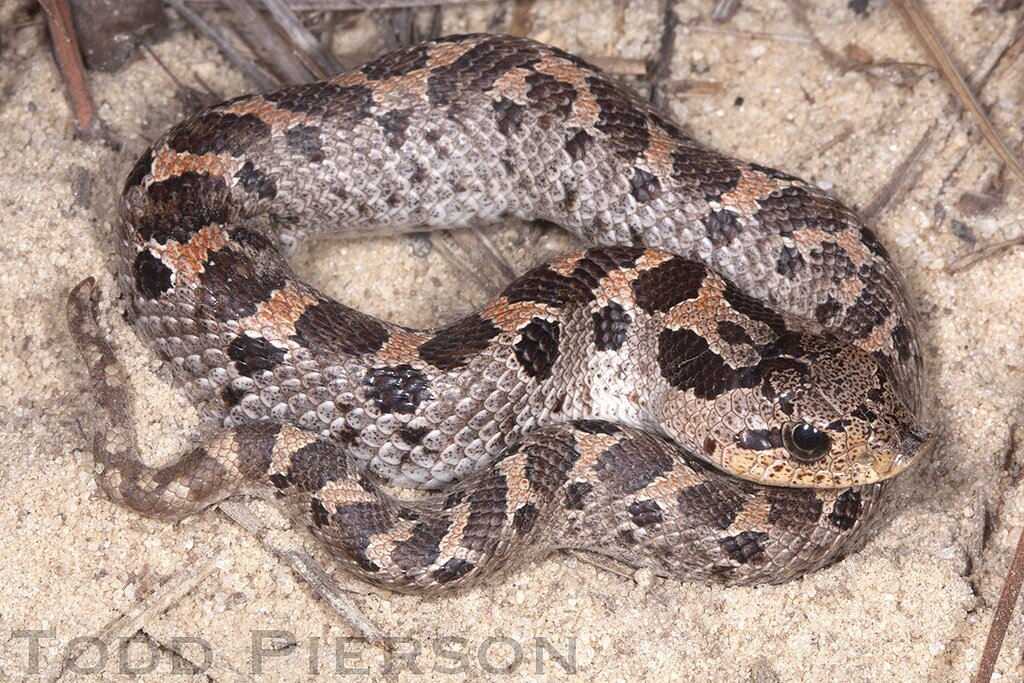Heterodin simus
This photo is licensed under CC BY-SA-NC
Identification: Have you ever had the opportunity to see this short but stout serpent basking in the sun while taking a stroll through the woods? If you have, consider yourself lucky! The Southern Hognose snake is an extremely shy and allusive non-venomous reptile (The Eastern Hognose does produce a mild venom). Though rarely seen, they can be identified by their distinct pointed, and upturned snouts. They average around 35.6 cm in length and have been recorded as long as 61cm. The females are generally larger than the males of this species. Both males and females are generally gray, with black blotches on their backs and sides, however they can have tan or auburn tints as well. The Southern Hognose is often misidentified as its cousin, the Eastern Hognose snake. When threatened, the Southern Hognose can spread their necks out, similar to a cobra, and hiss loudly. They rarely strike or bite in self-defense, but they have been documented rolling over onto their backs and “playing dead”. Their diet consists of lizards, rodents, and other small vertebrates, but they primarily feed on frogs and toads, using their posterior fangs to capture prey, and to deflate any toad or frog.
Distribution and Habitat: Historically found in coastal plains and upland forests of the eastern United States from North Carolina over to Mississippi, the Southern Hognose is now found only within scattered locations in the Southeast U.S. throughout the Carolinas, Georgia and Florida. They thrive in xeric upland sandhill habitats, including longleaf pine forests and other fire dependent ecosystems. Southern Hognoses are partially fossorial, digging burrows 0.2-0.5m underground and spending much of the time in these burrows. There is speculation that they may hibernate underground during the winter months. Females lay 6-14 eggs with a gestation period of approximately 65-70 days. The typical lifespan is 5 years for the Southern Hognose, with some snakes reaching up to 9 years of age.
Threats: As with many animal species, Southern Hognose snakes face many varying threats. Human encroachment, urban sprawl, habitat fragmentation and loss, and fire suppression efforts, are the major factors that threaten the Southern Hognose population. The introduction of Red imported fire ants, invasive frog/toad species that change the ecological processes of the habitat, and climate change have also become threats to both the Southern and Eastern Hognose snake populations. Predators of the Southern Hognose include Scarlet Kingsnakes, Eastern Indigo snakes, hawks and humans. Humans often mistake the Southern Hognose as dangerous pests and dispose of them. Many of these snakes are killed while crossing over roadways.
Population Status: Sadly, due to the secretive nature of this snake, very little ecological studies have been performed, hindering records regarding their population numbers and dynamics. The Southern Hognose snake has not been recorded or found in Alabama or Mississippi since the 1970’s, they are a protected species in Georgia. The Southern Hognose is listed as “Vulnerable” and some consider them to be one of the rarest and most threated snake species in North America. Restoration of longleaf pine ecosystems, prescribed/re-introduction of fire, and the maintenance of protected lands are key to the protection and health of this species.
Links for more information:
https://srelherpl.uga.edu/snakes/hetsim.htm
https://animaldiversity.org/accounts/Heterodon_simus/
https://www.fws.gov/southeast.pdf/fact-sheet/southern-hognose-snake.pdf

